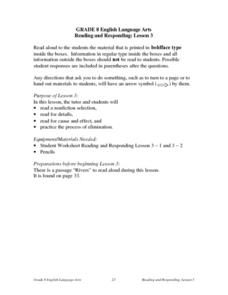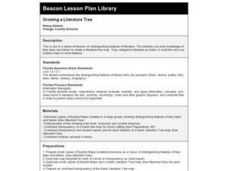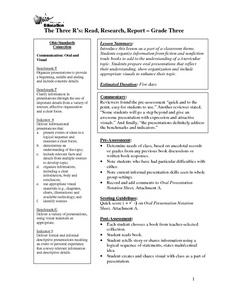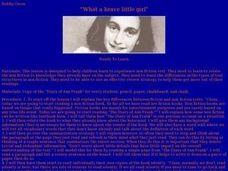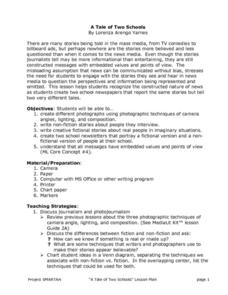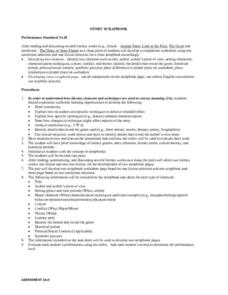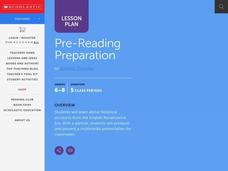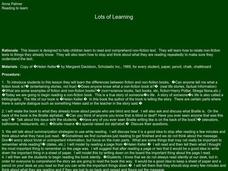Curated OER
Reading and Responding: Lesson 3
Reinforce comprehension of informational text. This is a one-on-one lesson intended to build an internal dialogue the reader can use to boost overall comprehension. They work independently with a tutor or teacher to read a nonfiction...
Curated OER
Titanic
Students conduct research with the purpose of writing a report about the Titanic. They use a variety of resources. The students produce a written document that has plenty of documented information. They also compare the information that...
Curated OER
Good Knight Alphabet Quest
Students will learn new words by using their favorite books. They will examine fiction and nonfiction works to differentiate types of literature. The lesson engages learners because it is using the format of a game to deliver instruction.
Curated OER
Growing a Literature Tree
Third graders use prior knowledge of fairy tales and fables to create a literature tree map. They categorize literature as fiction or nonfiction and use bubble maps to show features.
Curated OER
Rice is Nice
First graders explore Japanese foods through fairy tales, fiction and nonfiction books, cooking meals and eating with chopsticks. After all of the creative ideas have been utilized, the class holds a tea party for parents in the classroom.
Curated OER
Read Research and Report
Third graders organize information from fiction and nonfiction trade books to add to the understanding of a /curricular topic. They prepare oral presentations that reflect their understanding, show organization and include appropriate...
Curated OER
Chinese Minority Cultures
Seventh graders identify the elements that characterize culture in literature.
Students analyze the representation of Chinese minority peoples
through textbooks. Students identify and interpret the differences among the people of China.
Curated OER
We Like to Imagine - Animals
Young scholars describe a pretend animal. They read "The After School Monster." Students read other books and discuss whether or not the characters are real. Young scholars make a drawing of a pretend animal and of a real animal. They...
Curated OER
Go For The Gold!
Third graders read fiction and nonfiction works for comprehension. Using the internet, 3rd graders participate in a WebQuest. They compare and contrast the Olympics in ancient Greece to the modern day Olympics. Afterwards, students...
Curated OER
What a Brave Little Girl
Students practice relating non-fiction to knowledge they already have on the subject. They evaluate differences in the types of text structrures in non-fiction. They employ a review strategy that allows them to understand their reading.
Curated OER
Exploring the Library
Students explore ways to use the library as a resource for accessing research material. Working individually, they participate in a teacher created library scavenger hunt to aid in locating fiction and nonfiction material as well as...
Curated OER
A Tale of Two Schools
Learners create different photographs using photographic techniques of camera angles, lighting, and composition. They write non-fiction stories about people they interview and create two school newsletters that portray a fictional...
Curated OER
Who Invented English Anyway?
In these English lesson plans, young scholars use video, the Internet and non-fiction essays to research the history of the English language. They write a short research paper and design a PowerPoint presentation showcasing their findings.
Curated OER
Introduce Vocabulary: Owen and Mzee: The True Story of a Remarkable Friendship (Hatkoff & Kahumbu)
The heartfelt true story of Owen the hippopotamus and Mzee the 133-year-old tortoise will have budding readers engaged as they practice vocabulary in the context of Isabella Hatkoff's nonfiction story. Although you could include more,...
DeKalb County Schools
Compare/Contrast
A series of reading activities is sure to engage your young readers! Based on comparing and contrasting ideas, the packet provides opportunities to compare characters, themes, texts, and other elements of fiction.
EngageNY
Close Reading: Paragraph 4 of “Refugee and Immigrant Children: A Comparison”
Why is reading a text closely a helpful skill? Using the 13th of 20 lessons from the Grade 8 ELA Module 1, Unit 2 series, scholars continue reading the informational text "Refugee and Immigrant Children: A Comparison." They work with...
New York State Education Department
TASC Transition Curriculum: Workshop 5
Are video games sports? Pupils investigate this question as well as various nonfiction selections to learn more about claims and the support that defines them. All of the selections mimic the rigor on state tests and encourage close...
Curated OER
Story Scrapbook
Students develop a comparison worksheet using one non fiction book and one fiction book they have read to be put into a class scrapbook. In their comparison students must have title, author, point of view, setting, characters, and other...
Curated OER
Everybody Needs a Rock
Second graders examine science non-fiction books in the 500 section of the media center. They listen to Byrd Baylor's, Everybody Needs a Rock, and write a sentence that tells why everyone does need a rock. They illustrate the sentence.
Curated OER
Pre-Reading Preparation
Students explore a given historical fiction story. In groups, they research selected topics dealing with the story and determine what is fiction and what is fact. Students create a multimedia presentation about their findings and...
Curated OER
Analyzing Textbook Formats
Students explore the characteristics of a non-fiction text. For this comprehension lesson, students are led on a guided tour of each text and identify the features of a non-fiction text. Students continue to practice locating features...
Curated OER
Reading to Learn
Children learn to read and comprehend non-fiction text and explore how to relate non-fiction texts to things they already know. They then examine how to stop and think about what they are reading repeatedly to make sure they understand...
Curated OER
Putting the Truth in Writing
Students define "nonfiction" and describe what they view as the best pieces of nonfiction writing. They determine criteria to evaluate whether or not a piece of nonfiction writing is good, and list categories of nonfiction writing.
Curated OER
Animals attributes
First graders analyze different animals in fiction and nonfiction stories. In this animal lesson, 1st graders choose an animal and read a fiction story with that animal as a character. They describe how the animal acted in the story and...
Other popular searches
- Genre Fiction and Nonfiction
- Fiction and Nonfiction Text
- Nonfiction and Fiction
- Fiction Nonfiction Books
- Fiction and Nonfiction Events
- Fiction vs Nonfiction Books
- Nonfiction Fiction
- Twinning Fiction/nonfiction
- Fiction or Nonfiction Unit
- Fiction vs. Nonfiction Books
- Fiction/nonfiction Books
- Identify Fiction Nonfiction
